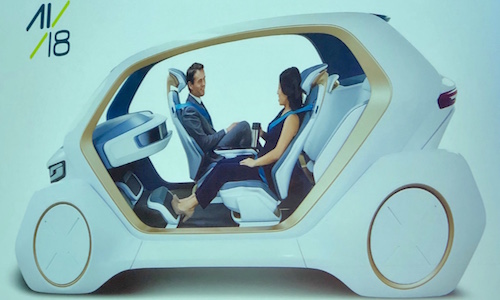
Blue Sky transport: From the earth to space and home again
By cameron in Uncategorized
Visionary designers shared their insights on the future of transportation, from automated cars, to high-speed rail and Hyperloop, on to adventures in orbit during the opening session of the Passenger Experience Conference in Hamburg.
Richard Chung, vice president, innovation and design for automotive seat maker Adient, which is making its entrance into the airline industry through a partnership with Boeing announced earlier this year, shared a vision of an automated car interiors designed for the purposes of riding, not driving.
He explains that transport as a function of life will override any need for automotive ownership in current generations, saying that children born now may not even apply for driver’s licenses.
While he sees some hurdles along the way before the majority of vehicles on the road are self-driving, the elements required are already falling in place.
“Technology is converging and the convergence of IoT, artificial intelligence and data are driving progress.
“There’s also a cultural shift. Consumers are changing their values. Owning a product is no longer a priority. It’s about having the experience…there’s also a change in our behaviour in terms of having things in an instant. Media, entertainment, shopping, urban mobility…everything needs to be instant so that we can save time to do the things we care about.
“What consumers really want is a seamless transition from door to door…What we see is the convergence, even of personal mobility and [transport] drones in future.”
Chung believes that the push forward will come from the companies already working on this type of transport for the future.
“An automotive company, or a company like Uber or Lyft or Didi in China. It’s ready for deployment as early as 2020. Tesla is already upping their game to get up to Level 3 self-driving. The technology is getting up there. It’s not quite there yet because it requires infrastructure..including the 5G network to get there.”
While we don’t perhaps think of advances in connectivity being a key hurdle to automated cities, the volume of data required to keep self-driving cars on track in a day-to-day transport function makes high-speed mobile data transfer being available in cities nearly as critical as having roads.

The Passenger Experience Conference 2018 highlights future transport modes
Paul Priestman, principal of London-based design firm Priestmangoode, which has long been involved in transport design including tubes, trains, and planes, shared the firms designs for high-speed rail travel and for Hyperloop travel.
In addition to the vital function these will play in getting humans around over long distances, Priestman also points out that these developing transport methods, including high-speed rail will reshape freight and logistics. Priestman also shares his agency’s elegant vision for personal product deliveries via drone.
Delivery butterflies…. by @Priestmangoode #PEC2018 pic.twitter.com/Y1QMMCLFjB
— FlightChic |
(@designerjet) April 9, 2018
Virgin Galactic’s head of design, Adam Wells, teased the audience with images of what space tourism will feel like when the first paying astronauts take off. He shares some of the challenges of designing a cabin experience under the varying conditions of the journey and assured the audience that the project is advancing though the first excursion is yet to be formally announced.
Tnooz asked the speakers what it takes to keep Blue Sky grounded, without losing the beauty of it, and to plan future technology so that it delivers on its original promise.
Paul Priestman says:
“Working in rail particularly, when you’re building infrastructure that will take 30 years or so to build, how do you plan for what’s going to happen? It is a very difficult one, politically as well for the engineers. When designing trains that are going to be running for 20 or 30 years is to design them in a modular way knowing that certain aspects are going to wear more quickly than other bits and make sure that those are the bits that have the currently technology.
“Things are progressing so quickly. If you go back two or three years, you’ll see things that were unknown. I think there is disruption happening in many other sectors, not just transportation…but in the autonomous vehicle area [you have to sort out legislation]. How can governments react quick enough to allow this to happen? Because it is happening, so it’s getting to a critical point.”
Richard Chung says consumers will drive change every bit as much as innovative designers, and put pressure on both the product manufacturers and regulators to deliver on expectations.
“The consumer pulls. Take smartphones—when the first apple iPhone came out, smartphones were still a dream. The negative opinion was that it was only be 30-40% of the market, the optimists gave it 70%. But today nearly 100% of people use smartphones—and not to make calls. The technology—if it’s attractive enough and resonates with consumer needs—will move much faster.
“The autonomous vehicle technology is one example, because there is so much anticipation by the public. So much has been promised. There are issues still, in terms of safety and being predictable and secure, but consumer pull will make that happen.”
Related reading:
Looking at the future of travel with autonomous vehicles
![]()


